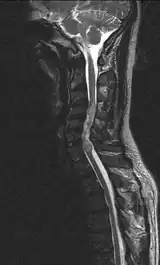Froin's syndrome
| Froin's syndrome | |
|---|---|
 | |
| Ependymoma of the cervical spine, completely obscurating the spinal canal |
Froin's syndrome – coexistence of xanthochromia, high protein level and marked coagulation of cerebrospinal fluid (CSF). It is caused by meningeal irritation (e.g. during spinal meningitis) and CSF flow blockage by tumour mass or abscess.[1] Stagnation of the CSF within the thecal sac facilitates exudation from the tumour itself and activation of coagulation factors. A clinical test formerly used for evaluation of spinal stenosis is Queckenstedt's maneuver. Nowadays, a magnetic resonance imaging is used for identification of CSF flow obstruction. It often shows the prolongation of T1 and T2 signal in CSF caudal to a level of block.[2] This phenomenon is named after Georges Froin (1874–1932), a French physician who first described it.[3][4]
References
- ↑ Govindarajan, R; Khan, T (August 2012). "Froin's syndrome: an uncommon mimicker of Guillain–Barre syndrome". European Spine Journal. 21 (8): 1674–5. doi:10.1007/s00586-012-2277-0. PMC 3535231. PMID 22447409.
- ↑ Mirza, S; Adams, WM; Corkhill, RA (May 2008). "Froin's syndrome revisited, 100 years on. Pseudo-Froin's syndrome on MRI". Clinical Radiology. 63 (5): 600–4. doi:10.1016/j.crad.2007.07.027. PMID 18374725.
- ↑ Froin's syndrome at Who Named It?
- ↑ Froin G. Inflammations méningées avec chromatique, fibrineuse et cytologique du liquide céphalo-rachidien. Gazette des hôpitaux, Paris 1903; 76:1005–1006.
External links